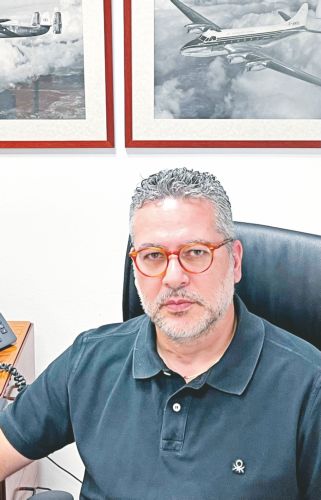The Air Traffic Control Agency is expected to handle about 420,000 flights a year, while in the past few days there has been increased pressure, with an additional 500 flights per day, due to turbulence in the Middle East. Revenues from these services amount to approximately €58 million per year.
But how is it managed and how are these services provided by the Republic of Cyprus charged? The Director of the Air Traffic Control Service, Harris Antoniadis, was asked to answer these questions.

According to Mr. Antoniadis, air traffic in the Nicosia FIR is controlled by the Larnaca and Paphos Control Towers, for movements at our airports and by the Flight Control Centre in Kokkinotrimithia for the entire Cyprus FIR, by a total of approximately 130 air traffic controllers, who manage a total of approximately 420,000 flights per year.
Recently, due to the turbulence in the Middle East, increased pressure has been recorded in Cypriot airspace, with about 500 additional flights daily. Mr. Antoniadis noted that all flights were managed with absolute safety.
Of course, these services are not offered free of charge, since each airline that uses the airspace of Cyprus pays a certain fee. It is important to note that the state's costs for the operation of these services do not exceed the revenues generated by the companies' charges.
More specifically, the fees are set every five years, based on estimates of the number of flights and overflights. In the event of a revision of the provisions, the fees may be adjusted accordingly.
As the Director of the Air Traffic Control Service explains, the overflight charge is calculated based on the distance travelled by an aircraft within the Nicosia FIR, depending on its type and weight.
Indicatively, an Airbus A320 aircraft operating the Larnaca-Athens route is required to pay fees of approximately €400 only for the use of Cypriot airspace.
Revenue equals expenses
Mr. Antoniadis emphasizes that the state's revenues from the relevant charges amount to about €58 million per year and are equal to the expenses for the management of Cypriot airspace.
Essentially, it would not be an exaggeration to say that the Air Traffic Control Service is self-financing, as salaries, overtime, equipment and other operating expenses do not burden the taxpayer. These expenses are entirely covered by the revenues collected by the companies and end up in the state coffers.
Asked about this, Mr. Antoniadis explained that the fees are calculated based on the estimated flights and are adjusted accordingly, so as to reflect the actual costs. From the context of Mr. Antoniadis, it follows that either the revenues are equal to the expenses or they generate a small surplus, while there is never any loss.
Regarding flight safety, Mr. Antoniadis underlined that Cyprus has both the necessary equipment and the required experienced human resources. However, he pointed out that it is necessary to recruit about 50 additional air traffic controllers, which will be added to the 130 already working in the Service.
Turkish Airlines and El AI
The statistics regarding overflights in the Nicosia FIR show that the two airlines that use Cypriot airspace with the most frequency are Turkish Airlines and Israel's El Al, due to the geographical location of the two countries.
It is worth noting that Turkish Airlines, Turkey's national carrier, pays its debts normally, as the relevant fees are collected by Eurocontrol and then returned to the Republic of Cyprus.
